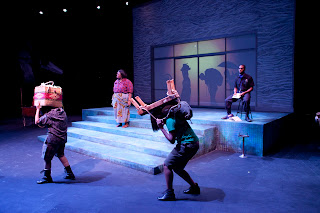The Beatification of Area Boy
Tuesday, November 30, 2010
Monday, November 1, 2010
Congratulations to our Cast and Crew for a Great Run!
Area Boy Cast
Ali Yalgin Judge/Cyclist/Miseyi’s Father
Colby Johnson Area Two-Four/Accused/ADC/Soldier/Prisoner
Andy Chu Trader
Afftene Taylor Barber
Jennifer Blocker Mama Put
Bailey Parks Boyko
Conrad Haynes Big Man Shopper/Minstrel/Military Officer/
Conductor/Band Leader
Conductor/Band Leader
Kimberly Goffe Girl/Miseyi’s Attendant/Another Witness
Brycen McCrary Sanda
Kyler Griffin Parking Attendant/Woman/Prisoner/MC
Julian Spector Foreigner/Prisoner 1/Soldier/Chief Kingboli
Yavuz Acikalin Victim/Prisoner 2/Soldier 1/Bridegroom
Neha Sharma Mother of the Day/Police/Prisoner/Newsvendor
Faraz Yashar Witness/Prisoner/Warder/final Soldier/
Military Governor
Military Governor
Ritza Calixte Shop Worker/Passenger/Prisoner/Miseyi
Director Jody McAuliffe
Percussionist Ben Crawford
Set Design Torry Bend
Costume Design Sonya Drum
Lighting Design Roz Fulton
Choreography Clay Taliaferro
Dramaturg Nina Billone Prieur
Musical Direction/Arrangement Todd Hershberger
Video Design WIlliam Noland
Stage Manager/Sound Board Operator Don Tucker
Asst. Stage Manager/Video Operator Merve Tahiroglu
Asst. Stage Manager Will Sutherland
Asst. Lighting Designer/Light Board Operator Ophelia Chua
Notes from the Director
DIRECTORS NOTES by Jody McAuliffe
JUDGE: (raises his head slowly to stare, like others) And what is that desolate throng? (The procession continues, seemingly endless. He seizes a pair of clippers and bangs it thrice on the table, formally.) The witness will answer all questions put to him and address the bench only. I said, what is that dismal throng?
Offered the opportunity to work with Wole Soyinka, I chose to direct The Beatification of Area Boy—a play in which the hero pointedly alludes to both Shakespeare’s Hamlet and Brecht’s Mother Courage. The forced displacement of Maroko residents from their homes in Nigeria, on prime Lagosian real estate, forms the central image of the play. This violent action provides the galvanizing force in the transformation of the hero from highwayman to hero. These days, we live in a time of severe displacement and the procession of the dispossessed is our story, too—one that must be told again, here and now, fifteen years after the play was written.
When I’m working on a new project, sometimes an idea flies in through the window like a bird, or I’m walking down the street and I stub my toe on a stone. Then I look down and find that the stone is just what I’ve been looking for. I had just seen William Kentridge’s animated battered humanity on display at MOMA and at the Met in his production of Gogol’s The Nose. My videographer, William Noland, and I considered going to Nigeria to shoot video for the production, and then to Ghana because the State Department had warned travellers about Nigeria. Then we stubbed our toes on our very own stone: Detroit.
Noland and I had both seen Andrew Moore’s grand, disturbing photos from Detroit Disassembled in the Times, especially the looming, skeletal, ominous Michigan Central Station. The magnificent photo of such elegant decay could not overtake the power of the thing itself: a huge empty monument to capitalism run amuck. We were horrified to discover that the once profitable, now defunct station is owned by a private individual—billionaire Matty Maroun (a name Brecht would have loved)—the very same private individual who owns the bridge from Detroit to Canada. I could not understand how such lunacy was possible in a major U.S. city. When a thing like a train station ceases to be profitable, it’s bad business to maintain it, so the owner lets it rot. When a place like Maroko needs to be destroyed, so that profitable luxury waterfront apartments can be erected, a million people are rendered homeless in a day.
In the parking lot behind the Duke Literature Program I happened to bump into my colleague Susan Willis. When I told her I was working on a Lagosian Kaleidoscope, she said I had to check out Rem Koolhaas’ documentary Lagos Wide & Close. In wide shot, the city is a fantastic kaleidoscope, up close—a hub of tremendous industry and vitality. In Area Boy, Soyinka gives us a world up close, a world at once Lagos and Detroit. When I told people I was going to Detroit to shoot, they looked at me as if I were nuts, or worse, deserving of pity. It was supposed to be a scary and dangerous place, a place that was dying or already dead. Death might be catching. On the other hand, our guides in Detroit wanted to make sure we were not planning to make poverty porn. They needn’t have been concerned. We were looking for the future, the seeds of it, and we met a version of Soyinka’s hero, Sanda—Hamlet, MacHeath, and Robin Hood rolled into one—in Southwest Detroit, living in Mexicantown.
What I found in this play was what we found in Detroit: a vibrant community with great food and a lot of fun, artistic innovation, a troubling past that continues to play itself out over and over, and a promise of hope for the future. Hope for a phoenix rising from the ashes. On our “toxic tour,” the young people working for Detroiters Working for Environmental Justice told us that if America will be reborn from its rubble it will have to start here—at the Packard Plant that has been standing empty for over fifty years. The troubles in Detroit—like the troubles in Area Boy—didn’t happen overnight. They’ve been festering for a long time. When the Judge asks—who is this throng—we are the ones sitting in the witness box. Soyinka demands a response.
It was the best vacation I’d had in years.
Friday, October 29, 2010
Soyinka Speaks About Urban Ruin and many other things...
Read the article here:
http://dukechronicle.com/article/soyinka-speaks-urban-ruin-lagos
And click this link for a resource list on urban ruin.
http://theaterstudies.duke.edu/uploads/assets/AREA BOY Mega-Slums.pdf
http://dukechronicle.com/article/soyinka-speaks-urban-ruin-lagos
And click this link for a resource list on urban ruin.
http://theaterstudies.duke.edu/uploads/assets/AREA BOY Mega-Slums.pdf
Thursday, October 28, 2010
Wednesday, October 27, 2010
Subscribe to:
Comments (Atom)





